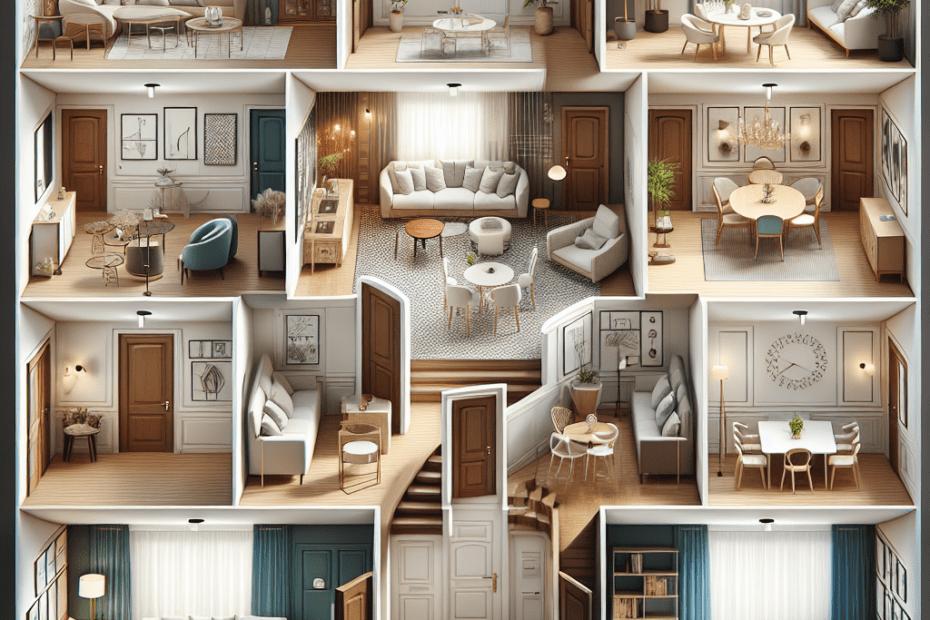“`html
The Best Furniture Layouts for Rooms with Multiple Entry Points
When arranging furniture in rooms with multiple entry points, many people face challenges as they attempt to create functional and aesthetically pleasing spaces. Rooms like these present unique design dilemmas, primarily because traditional layouts can block entryways, disrupt the flow, or make spaces feel crowded. This article delves into optimal furniture layouts tailored for rooms with several pathways, focusing on the keyword Multiple Entry Point Furniture.
Research by the Home Design Institute found that approximately 40% of homeowners encounter difficulties arranging furniture in rooms with multiple doorways. Such statistics highlight the importance of strategic layout design (Source: Home Design Institute, 2023).
Understanding the Challenges
Rooms with multiple entry points often serve as connective hubs, meaning that every piece of furniture needs to complement, rather than obstruct, foot traffic. By carefully choosing and placing furniture, individuals can ensure that movement throughout the room remains fluid and the space retains its intended purpose.
Optimal Furniture Layout Techniques
1. Zoning with Rugs
Rugs can effectively create distinct zones within a room. By grouping furniture around a rug in an open-plan space, they can define areas without blocking doorways. This approach ensures that open pathways maintain a natural flow while simultaneously designating specific areas for different functions.
2. Using Flexible Furniture
Incorporating flexible furniture like modular sofas or movable side tables can significantly enhance room adaptability. These pieces can be rearranged easily to suit the room’s purpose, making them ideal for spaces that need to accommodate varied activities while allowing entry points to remain accessible.
3. Arranging Seating Around the Periphery
For spaces that need both openness and structure, placing seating along the walls can help. This strategy opens up the central area, providing more entry paths and larger communal space ideal for gatherings.
4. Incorporating Vertical Storage
One way to minimize clutter and maximize space in rooms with multiple entry points is by using vertical storage solutions. By going upwards rather than outwards, more floor space becomes available for movement without compromising on storage needs.
5. Strategic Use of Lighting
Lighting can play a critical role in rooms with several entry points. Many homeowners prefer integrating multiple light sources, ensuring that every corner is well-lit and enhancing the room’s openness.
Table: Layout Strategies for Rooms with Multiple Entry Points
| Strategy | Description |
|---|---|
| Zoning with Rugs | Uses rugs to define specific areas without closing spaces. |
| Flexible Furniture | Employs movable and modular furniture for adaptability. |
| Seating Periphery | Arranges seating along walls to free central space. |
| Vertical Storage | Utilizes height for storage, freeing up floor space. |
| Strategic Lighting | Ensures good lighting across all areas, enhancing openness. |
Considerations for Effective Design
While furniture placement is key, other considerations include color schemes and room dimensions. Lighter colors can make spaces feel larger and more open, which is advantageous in multipathed rooms. Additionally, they should be mindful of room measurements to prevent overcrowding while accommodating multiple pathways.
They can also consider investing in multipurpose furniture that offers double functionality, like a sofa bed or storage ottoman. Such choices can offer additional functionality without occupying extra room space. According to a survey conducted by Interior Design Trends, 35% of customers now prefer multipurpose furniture for better utility in compact spaces (Source: Interior Design Trends, 2023).
Key Takeaways
- Rooms with multiple entry points require clever layout strategies for optimal functionality.
- Zoning, flexible furniture, and vertical storage solutions are highly effective.
- Being mindful of color choices and room dimensions aids in creating airy and open environments.
- Lighting and multipurpose furniture enhance usability and space management.
FAQ
Q1: What is the primary challenge of arranging furniture in rooms with multiple entry points?
A: The main challenge is ensuring that furniture placement neither obstructs pathways nor disrupts the flow within the room.
Q2: How can rugs help in arranging furniture in such rooms?
A: Rugs can zone specific areas within a space, helping to define purposes without blocking entry points.
Q3: What role does lighting play in rooms with multiple entry points?
A: Strategic lighting illuminates different areas, enhancing the perception of openness and connectivity throughout the room.
Q4: Why is flexible furniture recommended for these rooms?
A: Flexible furniture can be rearranged easily, adapting to the room’s needs while maintaining accessible pathways.
Q5: Are there specific color schemes that work best for such rooms?
A: Lighter color schemes can make rooms appear larger and brighter, helping maintain an open and welcoming atmosphere.
“`
